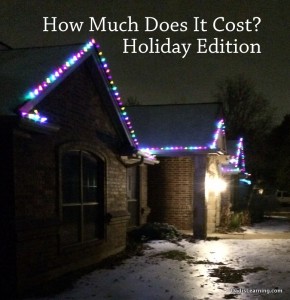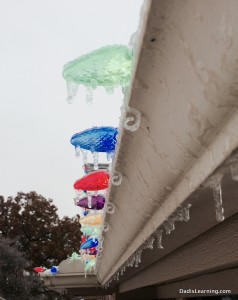How Much Does It Cost: Christmas Lights
UPDATE: Make sure to read an expensive lesson I learned during the 2014 Christmas light season. It is something to really consider before investing in LED technology.
After exploring the cost of leaving a light on, ghost power, and ceiling fans…I thought it was time to have a bit of “fun” and figure out how much it costs to light up our home at Christmas time. Thanks to my neighbors and some friendly strangers (more on that later) I used my Belkin Insight to find the watts consumed for a variety of Christmas decorations. Let’s take a look…
Ohhhh the lights…
 Who doesn’t enjoy looking at a few Christmas lights. The variance on power consumption among the different types of lights was pretty astounding. Three years ago we bought four 50′ strands of LED C9 style lights in a post-Christmas clearance sale. I paid $15 a strand for the lights which is a pretty good deal. This year I only put up two of the strands to cover the front of our house with 200 multi-color bulbs. I was pretty shocked by the power consumption.
Who doesn’t enjoy looking at a few Christmas lights. The variance on power consumption among the different types of lights was pretty astounding. Three years ago we bought four 50′ strands of LED C9 style lights in a post-Christmas clearance sale. I paid $15 a strand for the lights which is a pretty good deal. This year I only put up two of the strands to cover the front of our house with 200 multi-color bulbs. I was pretty shocked by the power consumption.
My lights use a measly 17.8 watts of power total. The math for determining the cost looks like this…
17.8 watts / 1,000 = 0.0178 kWh
.0178 kWh * 6 hours per day = 0.1068 kWh per day
.1068 kWh * $0.09 per kWh electric rate = $0.009612 cost per day
$0.00999612 * 32 days = $0.307584 total season cost
Over the past few days I have been running a contest to see if anyone could guess the cost of electric for my lights. The lowest guess was $0.92 and the highest was $450, which I kind of think was a type-o. So the actual cost was a third of the lowest guess. I was honestly shocked to find out our LED Christmas lights only cost $0.31 to run for the entire season. That is quite literally pocket change!
But what about some other popular styles of lights? I’ve got you covered…
Pre-lit Christmas Tree – We have a 7′ Christmas tree that is pre-lit with mini incandescent lights. Would you believe that little tree consumes 324 watts? Again, the cost over the entire season isn’t too bad. Using the same 6 hours per day calculation it costs approximately $0.18 a day and roughly $5.60 for the season.
Outdoor Icicle-style Lights – One of our neighbors on the street was kind enough to let me plug into their incandescent icicle style lights. They had 5 strands up to cover the front of their house. The lights consumed 340 watts and cost approximately $0.18 per day and $5.88 for the season.
Outdoor C9 Incandescent – Another neighbor on street let me plug into their traditional C9 lights that run the roof line of their house. This is the trusted and true style of screw in bulb incandescent Christmas light. They had four strands of lights on the front of the house and down the sides. The lights were using right at 1,400 watts of power at a cost of $0.75 per day and $24.20 for the season.
So, is it in your best interest to switch out those traditional incandescent lights for LED lights? I’ll answer that question in a second. But first let’s look at one more example with inflatables and lights!
A Christmas Enthusiast
On my way to work I pass by a house that is pretty well covered in Christmas lights and adorned with 8 inflatables out front, plus some lighted yard pieces and spotlights. It is a very nice display and I noticed that it seems to be on all day. One day last week I knocked on the door of the house and asked if they would let me test their setup. The homeowner excitedly agreed and helped me find all the plugs. There was a mix of incandescent and LED Christmas lights that were consuming 1,100 watts at a cost of $2.30 a day (based on 24 hour run-time) or $76 for the season.
The inflatables were using 625 watts of power. Several smaller inflatables, like Snoopy perched on his dog house, were using only about 25 watts each. But larger inflatables were using around 200 watts each. Cost per day is $1.34 and season cost is $42.85. The rest of the setup consisted of five 65-watt spotlights and 311 watts of yard art for a total usage of 636. Daily cost would be approximately $1.37 and season cost is $43.96.
This nice Christmas display was a perfect example for needing a few timers. Running 24 hours a day for a 32 day season is costing this homeowner approximately $162.81. This setup could be managed by three timers for a total investment of $60. Setting the timers for a 6-hour run-time would drop the season cost to $40.70 and most likely save the motors on the inflatable decorations from burning out. Even after buying the additional equipment, savings for the year would be around $60, plus larger amounts in the following years.
Time to replace the incandescent lights?
Whoa! Slow down there… I was pretty surprised how little it costs to run Christmas lights. Even the large incandescent C9 bulbs I mentioned above only cost $24.20 for the season. That low of a cost simply doesn’t justify running out to replace your incandescent lights with LED lights. If equivalent lights were purchased at a total cost of $60 it would take almost three seasons to break even on the energy savings. I’d consider making the change when the lights start to go out, but it is not something to rush out and do now.
The most valuable lesson was the need for a timer. We all tend to get busy and a bit forgetful this time of year. If you have a lot of lights and inflatables, it is well worth your time and money to invest in some timers. I don’t know about you, but I was surprised by the low cost of Christmas lights.
2014 Update: Another thing to consider about LED lights
Over the weekend I took advantage of a beautiful weekend to string up our outdoor LED lights. Our lights are now four years old and being put up on the house for the third time. If you haven’t used LED lights, they are really difficult to visually test in the daylight. I plugged in each strand and looked for a light here and there. A costly lesson awaited me…
I put up all four strands of lights on the gables and columns of our house. Anyone who has put up Christmas lights knows that this is no small feat. Our installation involves the use of two different ladders and the some time on the steep pitch of our roof. The girls were super excited to see the lights up and our oldest was very proud with her efforts in helping me put the lights up.
In the evening we flipped on the lights and you can imagine my disappointment when three different strings of lights had a section that didn’t come on. Fortunately all the sections were in places where the failure was not painfully obvious, but it was still frustrating. After doing some research I learned the following lessons:
- Many LED light strands are manufactured to be non-serviceable. This means the only thing that can be replaced on the strand is the fuse that is built into the plug. The lights themselves cannot be replaced or even removed for inspection.
- Each strand is divided into several segments using a non-serviceable inline fuse. If there is a problem (light out, wire break, etc.) that segment is isolated and will not work.
- Removing the in-line fuse will produce an extreme electrical and fire hazard.
- Tracking down and removing a malfunctioning LED would leave the segment of lights with an improper load which could also produce an electrical hazard.
When I purchased our LED lights I was uninformed enough to think I was buying a set of lights that would last for many years to come. This style of lights is made to be disposable at the first failure. Fortunately we only paid $15 per strand so the financial loss on these strands will not be that large. Imagine my disappointment if I had paid $30 to $50 per strand, which is the price you might pay at the store right now.
With their surprisingly low cost of operation and ease of repair, I believe the traditional incandescent screw in type bulb is the best long-term option for large outdoor lights.


Very interesting Jon. Yesterday as we were pulling down the lights from the attic and untangling them and trying very hard not to bust the bulbs; I was talking to Greg about replacing our traditional C9 bulbs with the LED ones. I think we’ll just hang on to them a while longer 🙂 They’ve been in our family for at least 10 years or more. They’ve moved with us from Ohio to Illinois and now here in Texas.
Thanks for all your information! I love it when you investigate things and share. Hope you all have a very blessed Christmas season!
Thanks Tammy! I was out messing around with my LED lights again last night and wish I had the trusted and true ‘traditional’ style Christmas lights. They may cost a bit more to operate but they last for years and years which is better for the pocketbook and the environment. Just like you said, they are durable.